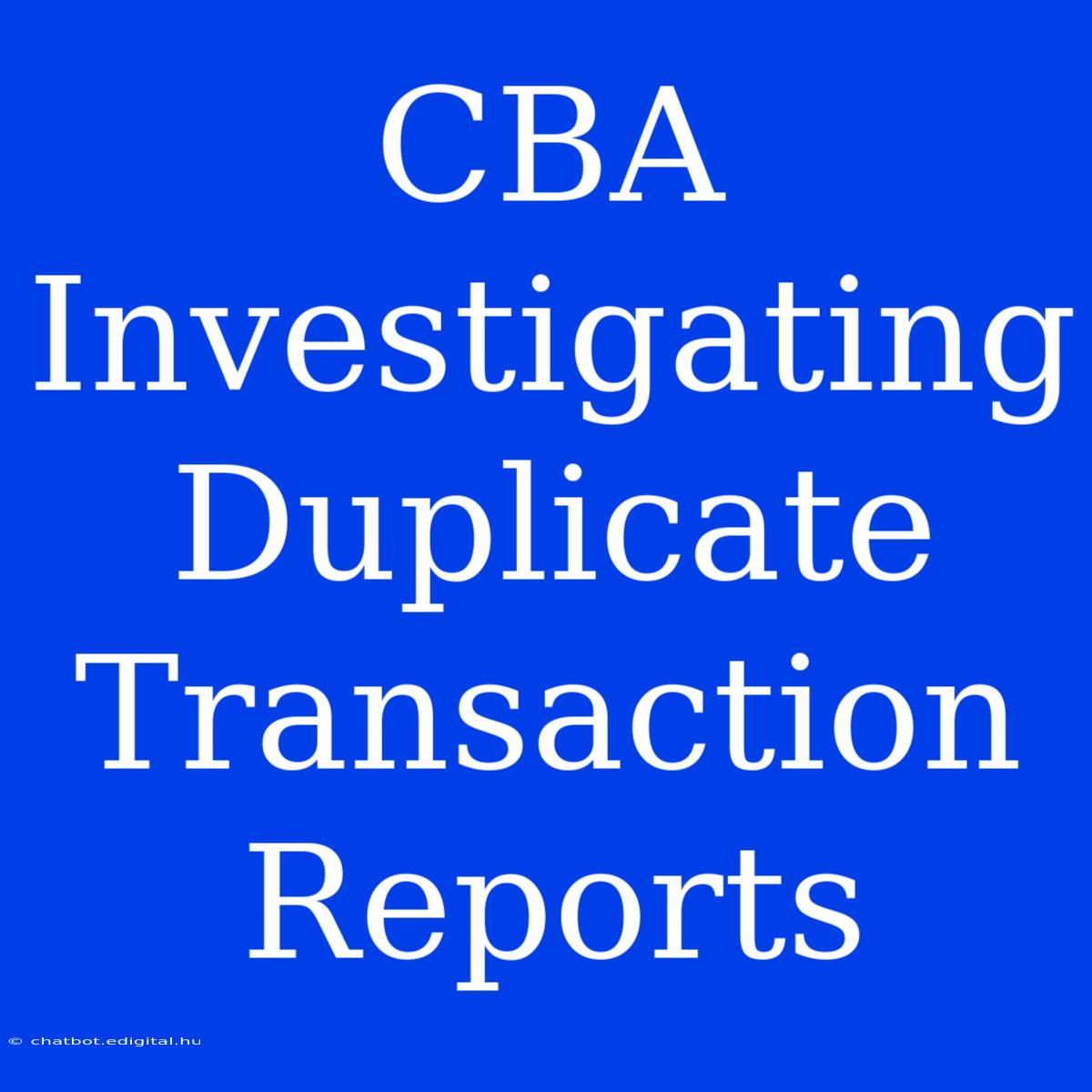CBA Investigating Duplicate Transaction Reports: A Closer Look at the Issue and Its Implications
Duplicate transaction reports are a significant concern for consumers and financial institutions alike. The Commonwealth Bank of Australia (CBA) is currently investigating numerous reports from customers claiming to have experienced duplicate transactions.
Editor's Note: The CBA's investigation into duplicate transaction reports highlights the importance of secure financial systems and customer protection.
Why is this important? Duplicate transactions can lead to financial hardship, impacting customers' budgets and causing unnecessary stress. It's crucial to understand the reasons behind these occurrences and explore ways to mitigate such risks.
Our analysis delves into the potential causes of duplicate transactions, examining various factors that may contribute to this problem. We aim to provide a comprehensive overview of the issue, empowering readers with insights to help them navigate similar situations.
Key Takeaways of the CBA's investigation:
| Key Takeaway | Description |
|---|---|
| System Glitches: Technical errors in the banking system could lead to duplicate transactions. | |
| Fraudulent Activity: Malicious actors might exploit vulnerabilities in the system to create duplicate transactions. | |
| User Error: Customers might mistakenly authorize duplicate transactions due to various reasons. |
What is CBA Doing?
The CBA is committed to investigating these reports thoroughly and taking appropriate action to prevent further occurrences.
System Glitches
- Introduction: System glitches are a common cause of duplicate transactions.
- Facets:
- Role: Technical failures in the banking system can result in unauthorized duplicate transactions.
- Examples: A server outage or a software bug could lead to unintended transaction processing.
- Risks & Mitigations: Banks invest in robust systems and regular updates to minimize glitches.
- Impacts & Implications: Unresolved system glitches can cause financial losses for both customers and the bank.
- Summary: While glitches are not always intentional, they can be a source of significant disruption and need to be addressed promptly by financial institutions.
Fraudulent Activity
- Introduction: Fraudulent actors may utilize various methods to exploit the banking system and create duplicate transactions.
- Facets:
- Role: Cybercriminals may target vulnerabilities in the system to manipulate transactions.
- Examples: Phishing scams, data breaches, and unauthorized access are common methods employed.
- Risks & Mitigations: Banks implement security measures like two-factor authentication and fraud detection systems.
- Impacts & Implications: Fraudulent activities can result in significant financial losses for victims and damage the reputation of the financial institution.
- Summary: Preventing fraudulent activities requires robust security measures and ongoing vigilance by both banks and customers.
User Error
- Introduction: Mistakes made by users can sometimes lead to duplicate transactions.
- Facets:
- Role: Customers might accidentally authorize duplicate transactions due to distractions or misunderstandings.
- Examples: Double-clicking on a transaction button, entering incorrect information, or using outdated payment methods can lead to unintended duplicate charges.
- Risks & Mitigations: Banks educate customers about secure online practices and provide clear transaction confirmation processes.
- Impacts & Implications: While unintentional, user errors can still result in financial burdens for individuals.
- Summary: Customer education plays a vital role in preventing user errors and ensuring secure financial transactions.
FAQ
- Introduction: This section addresses common questions related to duplicate transaction reports.
- Questions:
- Q: What are the typical signs of a duplicate transaction?
- A: Multiple charges for the same purchase, inconsistent transaction details, or unexpected activity on your account are telltale signs.
- Q: What should I do if I suspect a duplicate transaction?
- A: Contact your bank immediately and report the suspected duplicate transaction.
- Q: How long does it take for the bank to investigate a duplicate transaction?
- A: The investigation timeframe varies, but banks strive to resolve issues promptly.
- Q: What happens if the investigation reveals a duplicate transaction?
- A: The bank will typically refund the duplicate amount to your account.
- Q: How can I prevent duplicate transactions in the future?
- A: Review your transaction history regularly, enable two-factor authentication, and be cautious about suspicious emails or websites.
- Q: Can I get compensation for duplicate transactions?
- A: The bank may offer compensation if the duplicate transaction resulted from their negligence or a system glitch.
- Summary: Understanding the common concerns surrounding duplicate transactions can empower customers to take proactive measures.
Tips for Avoiding Duplicate Transactions
- Introduction: This section provides practical tips to minimize the risk of duplicate transactions.
- Tips:
- Double-check transactions: Before confirming any transaction, carefully review the details, especially the amount and recipient.
- Use secure payment methods: Opt for payment methods that require additional authentication steps, such as two-factor authentication.
- Be wary of phishing scams: Avoid clicking on suspicious links or opening attachments from unknown senders.
- Monitor your account activity: Regularly check your bank statements and online banking transactions for any irregularities.
- Report suspicious activity promptly: Contact your bank immediately if you suspect any unauthorized activity on your account.
- Summary: Implementing these simple tips can significantly reduce the risk of encountering duplicate transactions.
Concluding Thoughts
The CBA's investigation into duplicate transaction reports highlights the importance of financial security and transparency. While instances of duplicate transactions can be frustrating for customers, it's crucial to remember that banks are actively working to address such issues. By understanding the potential causes and implementing preventive measures, customers can play a proactive role in protecting their financial well-being.

